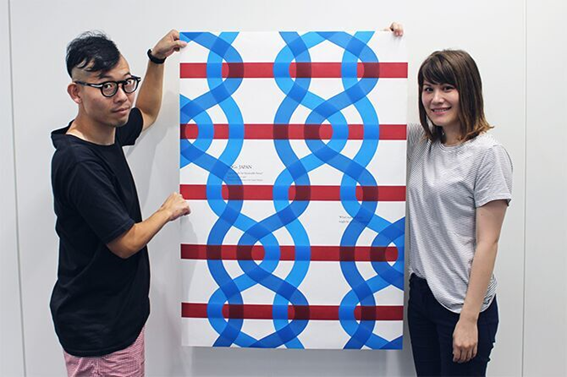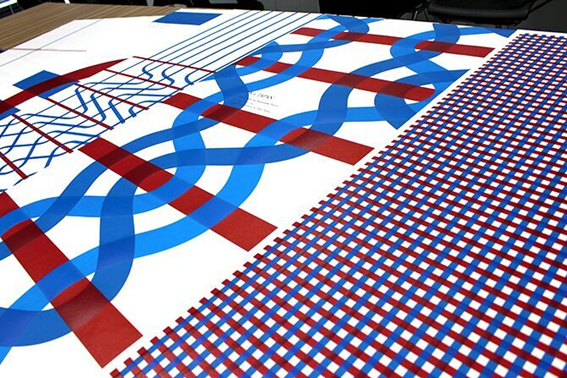
Dentsu Creative Direction Team Explain How They Tackled Japan's SDGs Approach with Just Two Lines

As countries around the world work to realise the United Nations’ Sustainable Development Goals (SDGs) by 2030, Japan is pursuing its own drive, promoted as the Public Private Action for Partnership.
Periodically, each country submits a report on its initiatives and their progress. When Japan put out its report for 2017, the five posters Dentsu had created for the government’s SDGs-related awareness campaign received high praise.
The five posters are together called One plus One. They feature a simple yet distinctive design, comprising thick, intertwined, red and blue lines interwoven like threads to represent the ties between public and private sectors, and the receptiveness of all people to the importance of the SDGs.
The posters won a Silver Lion in the Design category at the 2018 Cannes Lions. They also bagged a Gold advertising award in the Design category of the New York-based One Club’s advertising, design, interactive and branded entertainment competition, The One Show.
Now that the five posters have captured attention around the world, we find out below how the task was tackled from their creators: art director Yusuke Koyanagi, from Dentsu’s Creative Planning Division 4, and copywriter Maiya Kinoshita, from Dentsu’s PR Planning Division.

Proudly holding up one of the five posters they designed are Yusuke Koyanagi (left) and Maiya Kinoshita (right).
All roads lead from brainstorming

Q> How did you get the idea to intertwine lines?
Yusuke Koyanagi> Japan’s initiatives for accomplishing the Sustainable Development Goals are based on the main theme, Public Private Action for Partnership. So we tried to depict the cooperation between public and private sectors by interweaving horizontal and vertical lines.
Maiya Kinoshita> First we brainstormed, to decide on a motif to illustrate the public–private partnership. We collected some 100 photos of things such as stones and whirlpools, and shared opinions as we looked at them together.
Q> So brainstorming led to the motif?
Yusuke Koyanagi> That’s right. We needed a motif that could express Japan’s approach to the Sustainable Development Goals. With photos in hand, we held a brainstorming session and came up with the idea of the lines and the texture of material. We thought those elements appropriate because they are easily recognised as features of traditional Japanese design.
Q> Do you often hold brainstorming sessions?
Yusuke Koyanagi> Yes, and we had to particularly in this case. Since the posters are not advertisements we had no starting point for the motif. We found it by looking at photos of things and shapes.
Maiya Kinoshita> It felt as though we were collecting images. As the copywriter for the project, I brought a lot of ideas for copy to the brainstorming session. It was through that combined process that we decided to use lines and to give the posters the combined title, One plus One.
Q> How did you achieve depth with the lines?
Yusuke Koyanagi> The design is very simple, and we did our best to eliminate any flashy or decorative elements. We wanted the message embedded in the posters to be completely clear.
We paid close attention to detail. That resulted in the idea of making lines overlap. We used a UV inkjet printer and, since the ink hardened practically on the spot, we were able to apply a thick coat of it. That is what gives the design its depth.
Further, the posters are made of traditional Japanese washi paper, because we wanted to use Japanese materials where possible, given that the posters were for a United Nations event hosted by Japan.
Greater than the sum of their parts

Q> Is the copy based on verbal input from other team members?
Maiya Kinoshita< Yes. I tried to write copy that would motivate those who see the posters to take action themselves, and encourage everyone to work to accomplish the Sustainable Development Goals.
The concept of beginnings—suggested by a member—is something I expressed in the copy as “Beginnings don’t happen. We create them.” Innovation—also a suggestion—was another concept, and I conveyed it through the words, “What’s rejected today, might be praised tomorrow.”
Then, rather than express the concepts separately, I used them together. I wanted people to imagine the next step, because I wanted to inspire those around the world who see the posters. They reflect the joining of hands not only by public and private sectors, but also by Japan and other countries.
Q> Why was much of the copy placed on top of the lines?
Yusuke Koyanagi> One reason is that we wanted to embed the words in the texture to indicate that they embody the spirit of the posters. A second reason is that people would look at the posters more closely were the copy not easy to read. Another is that we thought people would be drawn to posters that have been carefully crafted.
Colleagues and end users
Q> How do the posters reflect your work styles and standards?
Yusuke Koyanagi> I believe it is important to meet andtalk with people in person. So, when making decisions, I avoid using email, insisting instead on face-to-face discussion. So as a consequence we used brainstorming to decide on the motif.
Further, if I want to show people some materials, I make sure I do so in person
Q> Could you explain your reasons?
Yusuke Koyanagi> I believe that people who meet and talk with others produce better creations. If I show someone some paper, for example, as we touch it and talk things over, different ideas will occur to us. And, in the interest of efficiency, one should make decisions during a meeting, not when on one’s own.
Q> How about your work style, Ms. Kinoshita?
Maiya Kinoshita> I invariably like to think about end users. Even now that I belong to a team that considers creative work from the standpoint of public relations, I still keep end users in mind.
When creating copy for the posters, I thought about how the people looking at them would react. Since they would be seen by government and business leaders with broad perspectives and from a number of countries, I tried to imagine myself in their shoes.
Moreover, since the Sustainable Development Goals are designed in the interests of the planet, I also considered the Earth to be an end user. While I know we cannot change things with posters, I did hope that they might—in some small way—help convey people’s hopes for our planet.
Q> What are your creative goals?
Yusuke Koyanagi> I want to do something really challenging. I worked hard to be a member of such a good company, so I want to contribute to advancing creative work in Japan. It may sound silly, but I truly believe a challenge like that suits me best.
Maiya Kinoshita> If I had to name my principal goal, it would be to become a creator who can inspire others. I don’t mean just as a copywriter, but as a person. I hope to become someone who gives courage to young people and women.
Then, of course, there is the Japan’s Creator of the Year award. It has never been given to a woman, so to be the first to win it is a dream that hovers at the back of my mind. But that is a truly big dream.













